Amazing and unusual musical instruments
A musical instrument is a device created or adapted for the purpose of making musical sounds. In principle, any object that produces sound can serve as a musical instrument—it is through purpose that the object becomes a musical instrument. The history of musical instruments dates back to the beginnings of human culture. The academic study of musical instruments is called organology.
The date and origin of the first device of disputed status as a musical instrument dates back as far as 67,000 years old; artifacts commonly accepted to be early flutes date back as far as about 37,000 years old. However, most historians believe determining a specific time of musical instrument invention to be impossible due to the subjectivity of the definition.
Musical instruments developed independently in many populated regions of the world. However, contact among civilizations resulted in the rapid spread and adaptation of most instruments in places far from their origin. By the Middle Ages, instruments from Mesopotamia could be found in Maritime Southeast Asia and Europeans were playing instruments from North Africa. Development in the Americas occurred at a slower pace, but cultures of North, Central, and South America shared musical instruments.
Have a look at some most amazing and unusual musical instruments:
A HAPI Drum
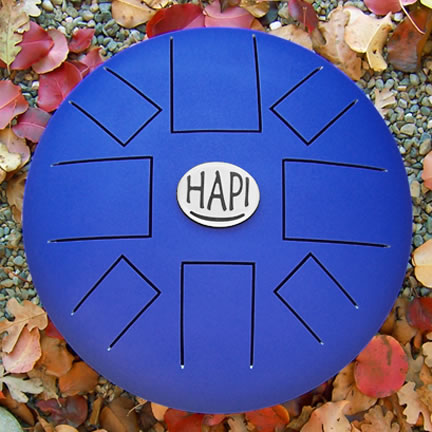
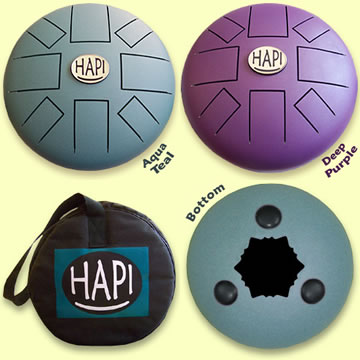
An easy to play melodic steel tongue drum, inspired by the Hang Drum, The unique tone of the HAPI Drum, available at HapiTones.com
is created by a tuned vibrating tongue of steel. The concept is
similar to a wooden tongue drum. When a tongue is quickly and lightly
struck with the finger or mallet, it vibrates creating sound waves.

Watch a video demo of the HAPI Drum:
Aeolian Wind Harp
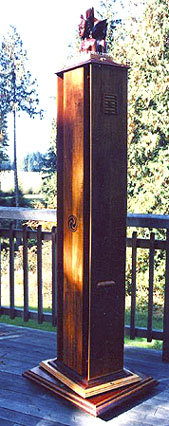
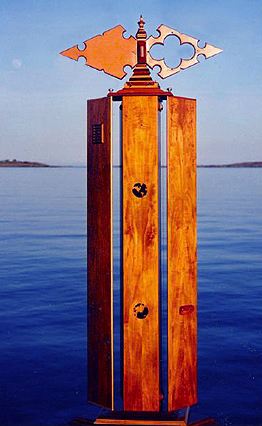
Played by the wind; free of the touch of human hands, Sometimes called Harmonic Harps, wind harps originated in ancient
Greece (circa 6 BC) and flourised throughout the Renaissance
era. Aeolian Harps are rare, beautiful instruments designed
to be played by the wind; free of the touch of human
hands.
Amazing Pencilina
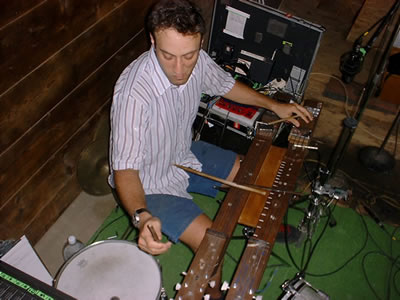
Collision of dulcimer, bass, koto, slide guitar. Bradford Reed fights and tames the idiosyncrasies
of the pencilina, an original instrument of his own design
and construction.The pencilina is an electric board zither played
primarily by striking the strings with sticks; also by plucking and
bowing.
Watch a video of Braford playing the Pencilina
Aquaggaswack
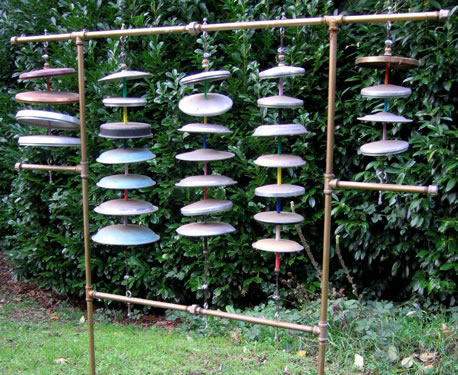
29 hanging pot lids, a gong tree with a wide sonic palette. he first version of the Aquaggaswack,
built in 1996, only had about 18 pot lids and was narrower (It didn't
have the outer sections). This second version, revamped in 1998,
has 29 pot lids representing a majority of the notes in an octave,
plus some quarter-tones. The center lids have mostly "bell"-like
tones and the outer sets have a more "gong"-like tone. All the lids
were obtained from thrift stores and friends.
Atlantic City Boardwalk Hall Organ
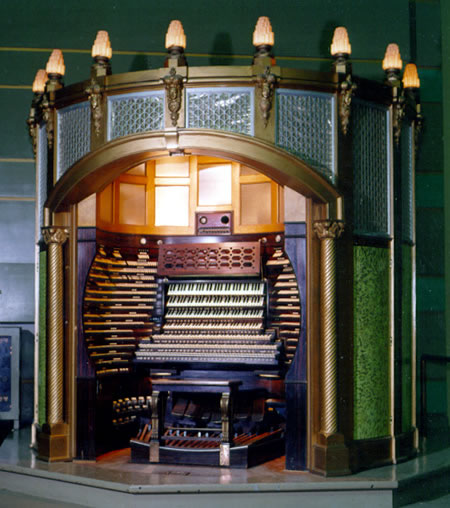
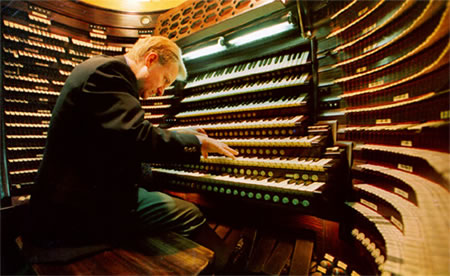
The massive organ has 33,112 pipes in 455 ranks, including a
full-length 64 foot Diaphone Profunda, ten 32 foot ranks, and manual
and pedal reeds that are under 100 inches of wind pressure, while most
organs never exceed 10 inches of pressure. In total, there are 4 stops
on 100 inches of wind pressure, and there are 10 stops on 50 inches of
wind pressure, ear burtsing stuff, but all in order to fill the giant
room with sound. The electric blowers that power the organ approach
1,000 horsepower, the kind of power needed to fill a hall larger than 15
million cubic feet. A tour of the entire organ takes 4 1/2 hours.
Balalaika
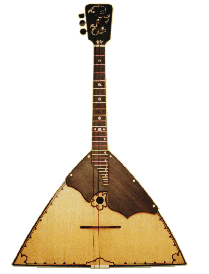
3-string folk instrument from Russia and the Ukraine. The Balalaika family includes, from
the highest-pitched to the lowest, the prima, sekunda,
alto, bass
and contrabass balalaika. All have three-sided bodies,
spruce or
fir tops and backs made of from three to nine wooden
sections, and
all have three strings. The most common solo instrument is
the prima, tuned E-E-A (the two lower strings being tuned to the same
pitch). The piccolo, prima, and secunda balalaikas are ideally strung
with gut (or, today, usually nylon) strings on the lower pegs and a wire
string on the top peg.
Bamboo Saxophones
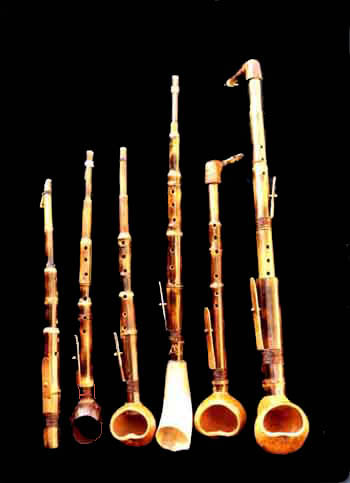
Sax's crafted by Ángel Sampedro del Rio. Carefully electronically
tuned, Ángel Sampedro del Rio's Bamboo saxophones consist of segments of
bamboo successively larger in diameter.
This progression has now
been demonstrated by acoustical studies as the most harmonically
effective.
Bandura
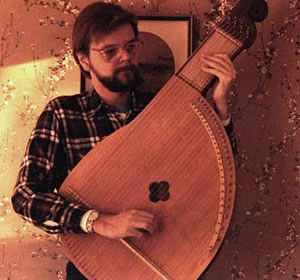
Ukrainian Bandura by Dwight Newton. Ukrainian bandura -- 36 strings, walnut/spruce,
original modified bracing pattern. The invention of an instrument combining the
elements of lute and psaltery itself is currently creditable to
Francesco Landini, an Italian lutenist-composer of trecento. Filippo
Villani writes in "Liber de civitatis Florentiae": "...(Landini)
invented a new sort of instrument, a cross between lute and psaltery,
which he called the serena serenarum, an instrument that produces an
exquisite sound when its strings are struck."
Glass
Armonica
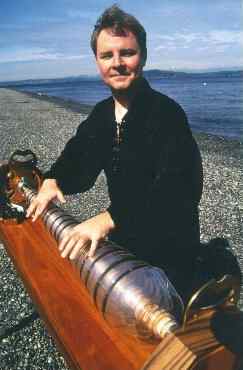
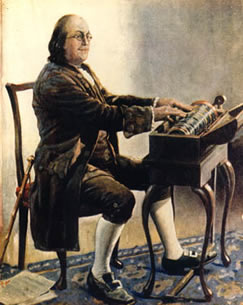
Invented in 1761 by Benjamin
Franklin, the Glass Armonica was one of his favorite
inventions. The word "Armonica" is the Italian
word for "Harmony". It is played on the same
principle of rubbing a wet finger around the rim of
a wineglass. The glass bowls are individually tuned,
so that they do not need to be filled with water, though
the players fingers do need to be moistened with water.
The glass bowls are tuned by size, mounted one inside
each other with cork on a metal spindle. The glasses
are made to spin with a flywheel attached to a foot
pedal. The composer Mozart, being into Oddmusic himself,
composed two of his works specifically for the Glass
Armonica.
Watch a video of playing the Glass Armonica
Synphonium
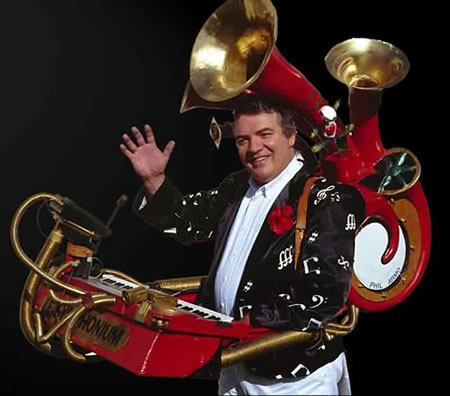
If you're ever in Toulouse, France,
look out for pianist Philippe Bataille and his Synphonium. A year in the making, powered by a car battery, it contains 2 synthesizers,
and other goodies too secret to be disclosed.
Wheelharp

While
adjusting his Hurdy Gurdy one day, Jon Jones of
Southeast Missouri thought it would be nice to be able to
select which string came into contact with the
wheel, and also have lots and lots
of strings!
After about a year and a half of working out the idea in his head, he found out about the Geigenwerk, which is very similar in principal, though the construction is quite a bit different. Jon stuck with his original design, because of all the planning he put into it, and like most creative experimenters, he just HAD to see if it worked.
After about a year and a half of working out the idea in his head, he found out about the Geigenwerk, which is very similar in principal, though the construction is quite a bit different. Jon stuck with his original design, because of all the planning he put into it, and like most creative experimenters, he just HAD to see if it worked.
The Javanese Bonang

The Javanese Bonang has a wooden frame on which brass gongs are
strung together. The brass heads are struck with padded sticks to create
the desired sound and tone.
Kalimbas



Kalimbas, also called thumb pianos, come from a family of instruments
with a wide variety of names, Mbira is probably the most well known.
They have their origin in many parts of Africa. These "Made in Oregon" Kalimbas are handcrafted from
homegrown gourds and a variety of hardwood tops. Each is carefully tuned
with two rows of keys tuned an octave apart. The lowest note is in the
center. To walk up the scale the thumbs alternate left-right, left-right
etc. To care for the instrument keep it dry and protected from long exposure to hot sun.











0 Comments